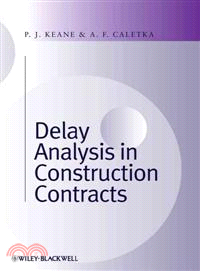DELAY ANALYSIS IN CONSTRUCTION CONTRACTS
商品資訊
定價
:NT$ 5075 元優惠價
:90 折 4568 元
若需訂購本書,請電洽客服 02-25006600[分機130、131]。
相關商品
商品簡介
作者簡介
名人/編輯推薦
目次
商品簡介
The most significant unanticipated costs on many construction projects are the financial impacts associated with delay and disruption to the works. Assessing these, and establishing a causal link from each delay event to its effect, contractual liability and the damages experienced as a direct result of each event, can be difficult and complex.
This book is a practical guide to the process of delay analysis and includes an in-depth review of the primary methods of delay analysis, together with the assumptions that underlie the precise calculations required in any quantitative delay analysis. The techniques discussed can be used on projects of any size, under all forms of construction contract, both domestic and international.
The authors discuss not only delay analysis techniques, but also their appropriateness under given circumstances, demonstrating how combined approaches may be applied where necessary. They also consider problematic issues including ‘who owns the float’, concurrent delay, early completion programmes, and disruption. The book, which is well illustrated, features practical worked examples and case studies demonstrating the techniques commonly used by experienced practitioners.
This is an invaluable resource to contractors, architects, engineers, surveyors, programmers and delay analysts, and will also be of interest to clients’ professional advisors managing extension of time or delay claims, as well as construction lawyers who require a better understanding of the underlying assumptions on which many quantitative delay analyses are based.
This book is a practical guide to the process of delay analysis and includes an in-depth review of the primary methods of delay analysis, together with the assumptions that underlie the precise calculations required in any quantitative delay analysis. The techniques discussed can be used on projects of any size, under all forms of construction contract, both domestic and international.
The authors discuss not only delay analysis techniques, but also their appropriateness under given circumstances, demonstrating how combined approaches may be applied where necessary. They also consider problematic issues including ‘who owns the float’, concurrent delay, early completion programmes, and disruption. The book, which is well illustrated, features practical worked examples and case studies demonstrating the techniques commonly used by experienced practitioners.
This is an invaluable resource to contractors, architects, engineers, surveyors, programmers and delay analysts, and will also be of interest to clients’ professional advisors managing extension of time or delay claims, as well as construction lawyers who require a better understanding of the underlying assumptions on which many quantitative delay analyses are based.
作者簡介
Dr. P. John Keane, chairman of Keane Associates, has thirty years' experience in the construction industry and is also an experienced arbitrator.
Anthony F. Caletka, PE, CFCC, CCM, is a managing director at PricewaterhouseCoopers and has twenty four years' experience in project and construction management, particularly on large civil engineering projects. He has had extensive experience of construction arbitration, litigation and dispute review boards and was a member of the SCL Delay and Disruption Protocol drafting committee.
Anthony F. Caletka, PE, CFCC, CCM, is a managing director at PricewaterhouseCoopers and has twenty four years' experience in project and construction management, particularly on large civil engineering projects. He has had extensive experience of construction arbitration, litigation and dispute review boards and was a member of the SCL Delay and Disruption Protocol drafting committee.
名人/編輯推薦
"This book provides an interesting insight into programming, planning and delay analysis terminology and techniques and is therefore a useful addition to the library of both students and practitioners." (The Expert and Dispute Resolver, Spring 2009)
"John Kean and Anthony Caletka are pukka analysts in that tricky area of delays, programming and extension of time. I highly recommend their book Delay Analysis in Construction Contracts. Both authors have extensive experience … .Buy the book." (Building Magazine, February 2009)
"The book's stated purpose is to provide a practical guide for those interested in schedule delay analysis. It provides a good in-depth review of the most common delay analysis techniques.... An excellent book, full of practical tips for the reader and very timely in its publication. it is well worth cost and a good read for anyone involved in schedule delay analysis." (Cost Engineering, February 2009)
"John Kean and Anthony Caletka are pukka analysts in that tricky area of delays, programming and extension of time. I highly recommend their book Delay Analysis in Construction Contracts. Both authors have extensive experience … .Buy the book." (Building Magazine, February 2009)
"The book's stated purpose is to provide a practical guide for those interested in schedule delay analysis. It provides a good in-depth review of the most common delay analysis techniques.... An excellent book, full of practical tips for the reader and very timely in its publication. it is well worth cost and a good read for anyone involved in schedule delay analysis." (Cost Engineering, February 2009)
目次
Preface.
1 Introduction.
1.1 General.
1.1.1 Purpose of ‘delay analysis in construction’.
1.1.2 Guidance.
1.1.3 Construction planning and programming.
1.2 Construction delays.
1.2.1 Identifying delays.
1.2.2 Analysing construction delays.
1.2.3 Delay claim life-cycle.
1.3 Burning issues in delay analysis.
1.4 Presentation and case study.
2 Construction Programmes.
2.1 Introduction.
2.1.1 Planning, Programming and Project Controls.
2.1.2 Elements of a successful project.
2.2 Planning and Programming.
2.2.1 Project Planning.
2.2.2 Work Breakdown Structure.
2.3 CPM Programming Techniques; the Fundamentals.
2.3.1 Activity Durations.
2.3.2 Activity Relationships.
2.3.3 Event Date Calculations.
2.3.4 Forward Pass.
2.3.5 Backward Pass.
2.3.6 Total Float.
2.3.7 Constraints.
2.4 Baseline Validation.
2.4.1 Joint Baseline Review.
2.4.2 Programme Approval.
2.4.3 The Project Baseline.
2.5 Other Planning Techniques.
2.5.1 PERT – Project Evaluation and Review Technique.
2.5.2 Gantt Charts (Bar Charts).
2.5.3 Line of Balance.
2.5.4 Critical Chain Method/Theory of Constraints.
2.6 Why use CPM Planning or Scheduling Techniques?.
2.6.1 Project Management.
2.6.2 As-planned programmes.
2.7 Project Controls and the Project Control Cycle.
2.7.1 Progress Monitoring.
2.7.2 Process and Analyse Information, Earned Value Method.
2.7.3 The Cost and Schedule Performance Curves.
2.7.4 Time Control.
2.7.5 Programme Updates.
2.8 Records, Records, Records….
2.8.1 Electronic Records.
2.9 Predatory Programming Practices.
2.10 Guidance.
3 Identification of Construction Delays.
3.1 Establishing a Basis for Identifying Delay.
3.1.1 General Requirements.
3.1.2 Validation of an As-Planned Programme.
3.2 Factual Evidence and As-Built Programmes.
3.2.1 As-Built Programme Preparation.
3.2.2 Summary.
3.3 Identification of Delay Events.
3.3.1 Delay Identification.
3.3.2 Recording Delays.
3.4 Identification and Analysis of Disruption.
3.4.1. Disruption and Delay.
3.4.2 Calculating Disruption.
3.4.3 Establishing Cause.
3.4.4 Total Cost Claims/Global Claims.
3.4.5 Measured Mile.
3.4.6 Graphical Presentation.
3.4.7 Summary.
4 Analysis of Construction Delays.
4.1 Introduction to Delay Analysis Techniques.
4.1.1 The use of CPM techniques.
4.1.2 Project Planning Software.
4.1.3 Identifying Delays – Cause or Effect?.
4.2 Explanation of the Available Techniques.
4.2.1 Additive Methods of Delay Analysis.
4.2.2 Impacted As-Planned.
4.2.3 Time Impact Analysis.
4.2.4 Collapsed As-Built.
4.2.5 As-Built Based Methods of Analysis.
4.2.6 Total Time Assessments.
4.2.7 As-Planned versus As-Built Windows Analysis.
4.2.8 Contemporaneous Windows Analysis.
4.2.9 Month-to-Month Update Analysis.
4.3 Selection Criteria and Guidance.
4.3.1 The SCL Delay and Disruption Protocol.
4.3.2 The Core Statements of Principle.
4.3.3 Recommended Practice No. 29R-03 ‘Forensic Schedule Analysis’.
4.3.4 Which technique to use under given circumstances.
4.4 Summary.
5 Problematic Issues.
5.1 Introduction.
5.2 Float and Delay Claims.
5.2.1 General Definitions -- What is ‘Float’?.
5.2.2 How Float is used.
5.2.3 Float Loss and the Impact.
5.2.4 Measurement of Float Loss.
5.2.5 Who Owns the Float?.
5.3 Concurrency.
5.3.1 Definitions.
5.3.2 Delay Analysis and Concurrency.
5.3.3 SCL Delay and Disruption Protocol.
5.3.4 Delay Scenarios.
5.3.5 Common Questions.
5.3.6 Experience and Commonsense.
5.3.7 The Concept of Pacing.
5.4 Programme Approvals and Onerous Specifications.
5.4.1 Programme Requirements, Format and Compliance.
5.4.2 Approval or Acceptance of Construction Programme.
5.5 Acceleration and Mitigation.
5.5.1 Mitigation.
5.5.2 Acceleration.
5.5.3 Contractors’ right to early completion.
6 Effective Presentation of Delay Analysis.
6.1 Introduction.
6.2 Case Study – Airport Terminal Expansion.
6.2.1 Initial analysis by party appointed planning experts.
6.2.2 Using Time Impact Analysis for Prolongation.
6.2.3 Tribunal Planning Expert’s Contemporaneous Approach.
6.2.4 Runway Extension - Are delays to the Runway Extension relevant?.
6.2.5 Terminal Building – Are delays to the Terminal Building relevant?.
6.3 Float Mapping - Approach and Methodology.
6.3.1 Extracting Float Values.
6.3.2 Create Float Map.
6.3.3 Identify Driving Activities.
6.3.4 As-Built Critical Path.
6.4 Demonstrating Acceleration.
6.5 Presentation Skills – Demonstrative Evidence.
6.5.1 Summary.
Index
1 Introduction.
1.1 General.
1.1.1 Purpose of ‘delay analysis in construction’.
1.1.2 Guidance.
1.1.3 Construction planning and programming.
1.2 Construction delays.
1.2.1 Identifying delays.
1.2.2 Analysing construction delays.
1.2.3 Delay claim life-cycle.
1.3 Burning issues in delay analysis.
1.4 Presentation and case study.
2 Construction Programmes.
2.1 Introduction.
2.1.1 Planning, Programming and Project Controls.
2.1.2 Elements of a successful project.
2.2 Planning and Programming.
2.2.1 Project Planning.
2.2.2 Work Breakdown Structure.
2.3 CPM Programming Techniques; the Fundamentals.
2.3.1 Activity Durations.
2.3.2 Activity Relationships.
2.3.3 Event Date Calculations.
2.3.4 Forward Pass.
2.3.5 Backward Pass.
2.3.6 Total Float.
2.3.7 Constraints.
2.4 Baseline Validation.
2.4.1 Joint Baseline Review.
2.4.2 Programme Approval.
2.4.3 The Project Baseline.
2.5 Other Planning Techniques.
2.5.1 PERT – Project Evaluation and Review Technique.
2.5.2 Gantt Charts (Bar Charts).
2.5.3 Line of Balance.
2.5.4 Critical Chain Method/Theory of Constraints.
2.6 Why use CPM Planning or Scheduling Techniques?.
2.6.1 Project Management.
2.6.2 As-planned programmes.
2.7 Project Controls and the Project Control Cycle.
2.7.1 Progress Monitoring.
2.7.2 Process and Analyse Information, Earned Value Method.
2.7.3 The Cost and Schedule Performance Curves.
2.7.4 Time Control.
2.7.5 Programme Updates.
2.8 Records, Records, Records….
2.8.1 Electronic Records.
2.9 Predatory Programming Practices.
2.10 Guidance.
3 Identification of Construction Delays.
3.1 Establishing a Basis for Identifying Delay.
3.1.1 General Requirements.
3.1.2 Validation of an As-Planned Programme.
3.2 Factual Evidence and As-Built Programmes.
3.2.1 As-Built Programme Preparation.
3.2.2 Summary.
3.3 Identification of Delay Events.
3.3.1 Delay Identification.
3.3.2 Recording Delays.
3.4 Identification and Analysis of Disruption.
3.4.1. Disruption and Delay.
3.4.2 Calculating Disruption.
3.4.3 Establishing Cause.
3.4.4 Total Cost Claims/Global Claims.
3.4.5 Measured Mile.
3.4.6 Graphical Presentation.
3.4.7 Summary.
4 Analysis of Construction Delays.
4.1 Introduction to Delay Analysis Techniques.
4.1.1 The use of CPM techniques.
4.1.2 Project Planning Software.
4.1.3 Identifying Delays – Cause or Effect?.
4.2 Explanation of the Available Techniques.
4.2.1 Additive Methods of Delay Analysis.
4.2.2 Impacted As-Planned.
4.2.3 Time Impact Analysis.
4.2.4 Collapsed As-Built.
4.2.5 As-Built Based Methods of Analysis.
4.2.6 Total Time Assessments.
4.2.7 As-Planned versus As-Built Windows Analysis.
4.2.8 Contemporaneous Windows Analysis.
4.2.9 Month-to-Month Update Analysis.
4.3 Selection Criteria and Guidance.
4.3.1 The SCL Delay and Disruption Protocol.
4.3.2 The Core Statements of Principle.
4.3.3 Recommended Practice No. 29R-03 ‘Forensic Schedule Analysis’.
4.3.4 Which technique to use under given circumstances.
4.4 Summary.
5 Problematic Issues.
5.1 Introduction.
5.2 Float and Delay Claims.
5.2.1 General Definitions -- What is ‘Float’?.
5.2.2 How Float is used.
5.2.3 Float Loss and the Impact.
5.2.4 Measurement of Float Loss.
5.2.5 Who Owns the Float?.
5.3 Concurrency.
5.3.1 Definitions.
5.3.2 Delay Analysis and Concurrency.
5.3.3 SCL Delay and Disruption Protocol.
5.3.4 Delay Scenarios.
5.3.5 Common Questions.
5.3.6 Experience and Commonsense.
5.3.7 The Concept of Pacing.
5.4 Programme Approvals and Onerous Specifications.
5.4.1 Programme Requirements, Format and Compliance.
5.4.2 Approval or Acceptance of Construction Programme.
5.5 Acceleration and Mitigation.
5.5.1 Mitigation.
5.5.2 Acceleration.
5.5.3 Contractors’ right to early completion.
6 Effective Presentation of Delay Analysis.
6.1 Introduction.
6.2 Case Study – Airport Terminal Expansion.
6.2.1 Initial analysis by party appointed planning experts.
6.2.2 Using Time Impact Analysis for Prolongation.
6.2.3 Tribunal Planning Expert’s Contemporaneous Approach.
6.2.4 Runway Extension - Are delays to the Runway Extension relevant?.
6.2.5 Terminal Building – Are delays to the Terminal Building relevant?.
6.3 Float Mapping - Approach and Methodology.
6.3.1 Extracting Float Values.
6.3.2 Create Float Map.
6.3.3 Identify Driving Activities.
6.3.4 As-Built Critical Path.
6.4 Demonstrating Acceleration.
6.5 Presentation Skills – Demonstrative Evidence.
6.5.1 Summary.
Index
主題書展
更多
主題書展
更多書展本週66折
您曾經瀏覽過的商品
購物須知
外文書商品之書封,為出版社提供之樣本。實際出貨商品,以出版社所提供之現有版本為主。部份書籍,因出版社供應狀況特殊,匯率將依實際狀況做調整。
無庫存之商品,在您完成訂單程序之後,將以空運的方式為你下單調貨。為了縮短等待的時間,建議您將外文書與其他商品分開下單,以獲得最快的取貨速度,平均調貨時間為1~2個月。
為了保護您的權益,「三民網路書店」提供會員七日商品鑑賞期(收到商品為起始日)。
若要辦理退貨,請在商品鑑賞期內寄回,且商品必須是全新狀態與完整包裝(商品、附件、發票、隨貨贈品等)否則恕不接受退貨。

















![漂鳥集[中英雙語版]](https://cdnec.sanmin.com.tw/product_images/957/957146403.jpg)





